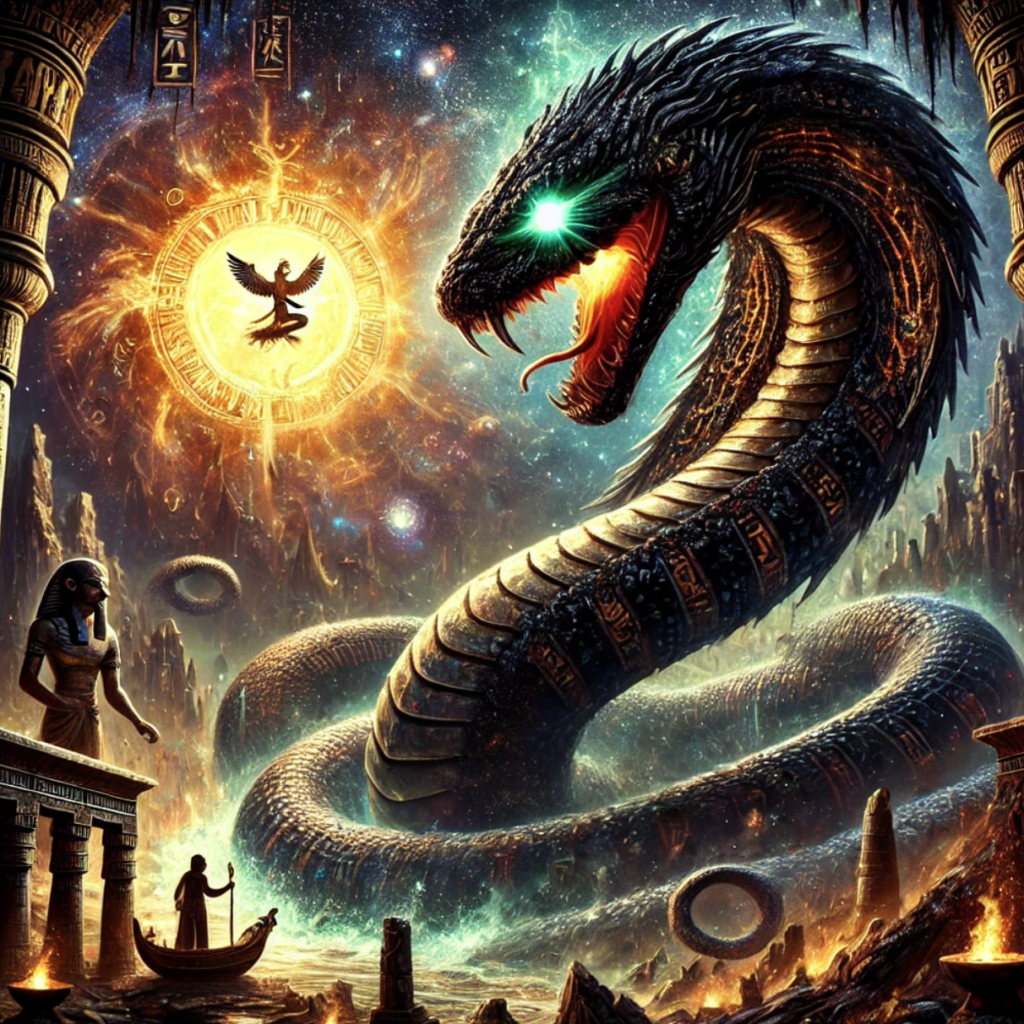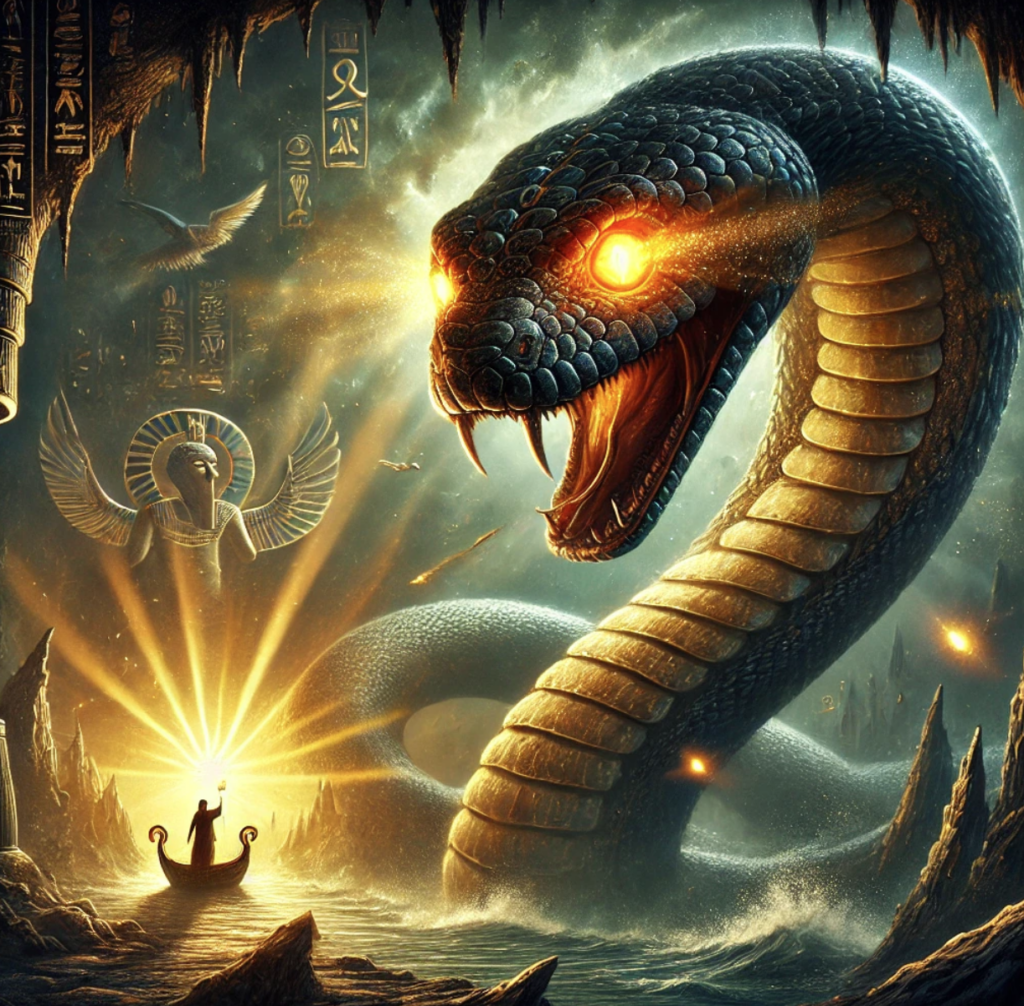Apepi / Aapep / Apophis / Ⲁⲫⲱⲫ / Ἄποφις
Apep (also known as Apepi, Aapep, Apophis, or Ⲁⲫⲱⲫ in Coptic, and Ἄποφις in Greek) is one of the most ancient and fearsome figures in Egyptian mythology. Apep was considered the embodiment of chaos (Isfet) and a malevolent force, constantly battling the gods, especially the sun god Ra, to plunge the world into darkness and disorder. Apep’s association with darkness, destruction, and chaos made him the greatest adversary of the cosmic order (Ma’at) in ancient Egyptian beliefs.


Apep in Egyptian Mythology
- The Great Serpent of Chaos: Apep is typically depicted as a giant serpent or dragon, sometimes stretching for miles. He was seen as the eternal enemy of Ra, and by extension, the cosmic order that Ra represented. Apep’s colossal size and serpent form symbolized his vast, destructive power and the fear that chaos would engulf the world if not kept in check.
- Eternal Enemy of Ra: Apep’s primary mythological role was as an adversary to the sun god Ra. Every night, Ra would travel through the Duat (the Egyptian underworld) in his solar boat to bring the sun from the western horizon to the east, where it would rise again. Apep would lie in wait, ambushing Ra and his companions to try to stop the sun from rising and plunge the world into eternal darkness.In some versions of the myth, Ra is aided by other gods, such as Set (Seth), the god of storms and chaos, who battles Apep to protect Ra during the journey. In other versions, Ra’s allies include gods like Bastet and Sekhmet, who help fend off the serpent’s attacks. Each night, Ra triumphs over Apep, symbolizing the daily victory of order over chaos and the rising of the sun as a sign that balance has been maintained.
- Representation of Isfet (Chaos): Apep was the personification of Isfet, the Egyptian concept of chaos, disorder, and evil. While Ma’at represented truth, order, and balance, Apep stood for the opposite. His attempts to stop the sun’s journey through the underworld were seen as efforts to overthrow Ma’at and bring about the destruction of the world. Apep’s defeat every night reaffirmed the idea that Ma’at would always triumph over Isfet, though the struggle was eternal.
- Appearance and Attributes: Apep is almost always portrayed as a massive snake or serpent, emphasizing his association with primordial chaos and destruction. In ancient Egyptian art, he is depicted as a dark, monstrous figure lurking beneath the earth, waiting to strike. His sheer size and strength were seen as overwhelming and terrifying, making him a potent symbol of the uncontrollable forces of nature.
Battles with the Gods
- The Ritual Defeat of Apep: The struggle between Apep and Ra was ritually reenacted by priests in ancient Egypt. In the Temple of Karnak, the Ritual of Overthrowing Apep was performed, where effigies of Apep were destroyed to symbolize the triumph of order over chaos. These rituals were meant to assist Ra in his nightly battle against Apep and to ensure the continuity of cosmic order.
- The Role of Set: In certain versions of the myth, Set, who is typically associated with chaos and violence, was ironically one of Ra’s strongest defenders against Apep. This complex relationship highlights the Egyptian understanding of balance and duality, where even chaotic gods like Set had a role to play in maintaining order in the universe. Set’s role in defeating Apep underlines the idea that both order and chaos are necessary components of life.
- Daily Victory: Every night, Apep’s attempt to consume Ra and plunge the world into eternal darkness was unsuccessful, and Ra would defeat Apep, allowing the sun to rise in the east. This victory was seen as temporary, as the battle would resume the next night. Apep’s persistence in returning each night represented the never-ending threat of chaos, and the gods’ eternal vigilance symbolized the constant effort required to maintain balance and harmony in the world.
Symbolism of Apep
- Chaos and Darkness: Apep’s central role in Egyptian cosmology was as the embodiment of chaos, darkness, and destruction. In a land where the sun and the Nile River were critical to life, Apep represented everything that was opposed to the sustenance and balance provided by these forces. The fear of Apep was rooted in the terror of eternal night, destruction of crops, and the collapse of cosmic order.
- Ma’at vs. Isfet: Apep’s opposition to Ra and Ma’at is a reflection of the constant struggle between order and chaos, a core theme in Egyptian thought. The Egyptians believed that for the world to continue functioning, Ma’at had to be preserved, and Apep, as the representation of Isfet, had to be constantly defeated. This duality between chaos and order was not seen as a one-time event but as a perpetual cosmic battle.
- Evil and Fear: While many Egyptian gods had both positive and negative aspects, Apep was a being of pure malevolence. Unlike the gods, he was not worshipped, and no temples were built in his honor. Instead, rituals and prayers were designed to help defeat or ward off Apep. His role in mythology was to inspire fear, reminding Egyptians of the importance of upholding Ma’at to prevent chaos from consuming the world.
Apep in Later Traditions
- Apophis in Greek and Roman Interpretations: The Greeks and Romans, who encountered Egyptian religion, adopted Apep into their own cosmologies under the name Apophis. Although the figure of Apophis was similar, Greek and Roman interpretations tended to place more emphasis on Apep as a monster or dragon, paralleling their own myths of chaotic serpents, such as Typhon in Greek mythology.
- Modern Associations: In modern times, Apep (or Apophis) continues to appear in various works of fiction, often portrayed as a massive serpent or dragon representing chaos or destruction. He has been featured in books, movies, and video games, where he is typically depicted as a malevolent force that must be defeated to restore balance.
Conclusion
Apep, also known as Apophis, is one of the most enduring symbols of chaos and evil in ancient Egyptian mythology. His nightly battles against Ra in the underworld represented the ongoing struggle between order and disorder, light and darkness, and life and destruction. Apep’s role as the embodiment of Isfet made him a feared and reviled figure in Egyptian culture, and his defeat each day reaffirmed the Egyptians’ faith in the triumph of Ma’at, the principle of truth and balance.
Description

Apep (𓇕𓊪𓊪𓆚) is an ancient Egyptian deity who appeared as a giant serpent. Apep was the greatest enemy of Ra the solar deity and had the title “Lord of Chaos” as Ra upheld order and brought light. [1,2]
Described as reaching 16 yards in length and having a head made of flint he was said to have a great battle against Ra who would take the form of a cat in order to defeat the serpent. [2,3]
Although mostly being depicted as a snake Apep is sometimes depicted as a crocodile. [4]
Origin
There are two commonly described origins of Apep. The first being that he existed from the beginning of time in the waters of Nu of primeval chaos. [2]
The other explanation ties Apep even closer to Ra saying that he was born from Ra’s umbilical chord. [5]
Worship
Egyptian priests and worshippers prayed each night to ensure Ra’s victory and they practiced a number of rituals that were thought to ward of Apep. In an annual rite called the Banishing of Chaos the priests would build an effigy of Apep and burn it.
The Books of Overthrowing Apep was considered a detailed guide to fighting the deity and included these steps:
Spitting Upon Apep
Defiling Apep with the Left Foot
Taking a Lance to Smite Apep
Fettering Apep
Taking a Knife to Smite Apep
Putting Fire Upon Apep
[6]
Similar Myths
It is easy to draw similarities between Apep and other creatures of myth simply due to there existing a large number of serpent deities. One interesting connection however is with the Norse world serpent Jörmungandr as Apep gained the title World-encircler due to him being described as living in many different places. [2]
Also similar is Sköll child to the great Norse wolf Fenrir as he is destined to consume the sun in a similar fashion to Apep’s battle against the sun and the sun deity.
Resources:
[1]: G. Pinch, Egyptian Mythology, (2004)
[2]: C. Wolterman, in Jaarbericht van Ex Oriente Lux, Leiden Nr.37 (2002).
[3]: J. Assmann, Egyptian Solar Religion in the New Kingdom, transl. by A. Alcock (London, 1995), 49-57.
[4]: S., Mercatante, Anthony (2009). The Facts on File encyclopedia of world mythology and legend. Dow, James R. (3rd ed.). New York: Facts On File. ISBN9780816073115. OCLC184982566.
[5]: Kemboly, Mpay. 2010. The Question of Evil in Ancient Egypt. London: Golden House Publications.
[6]: P.Kousoulis, Magic and Religion as Performative Theological Unity: the Apotropaic Ritual of Overthrowing Apophis, Ph.D. dissertation, University of Liverpool (Liverpool, 1999), chapters 3-5.
Author

Josh Morley holds a Bachelor’s degree in Theology from the Trinity School of Theology and a Diploma in Theology from the Bible College of Wales. His academic journey involved interfaith community projects and supporting international students, experiences that shaped his leadership and reflective skills. Now based in Liverpool, Josh is also the founder of Marketing the Change, a digital agency specializing in web design and marketing.
View all posts




